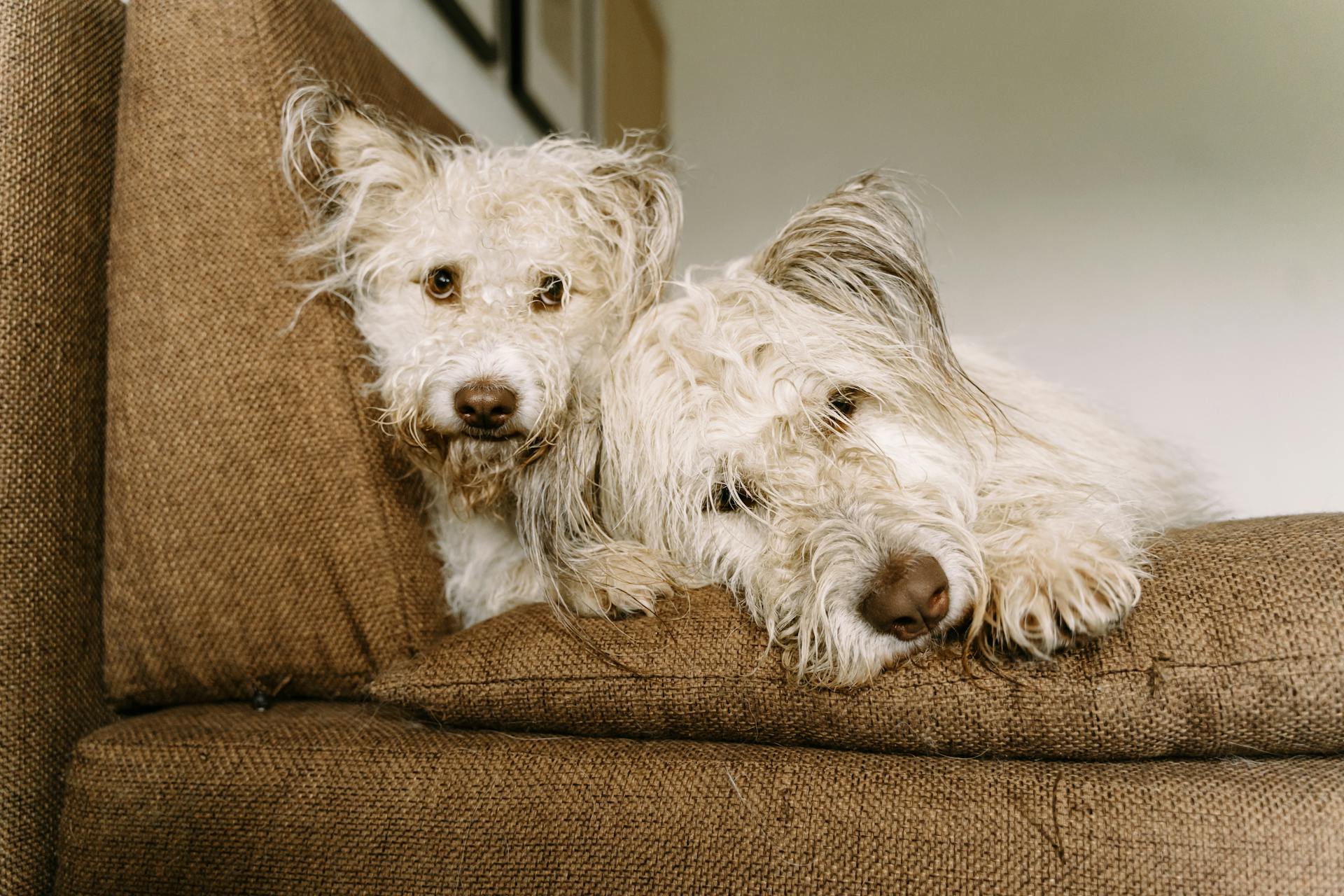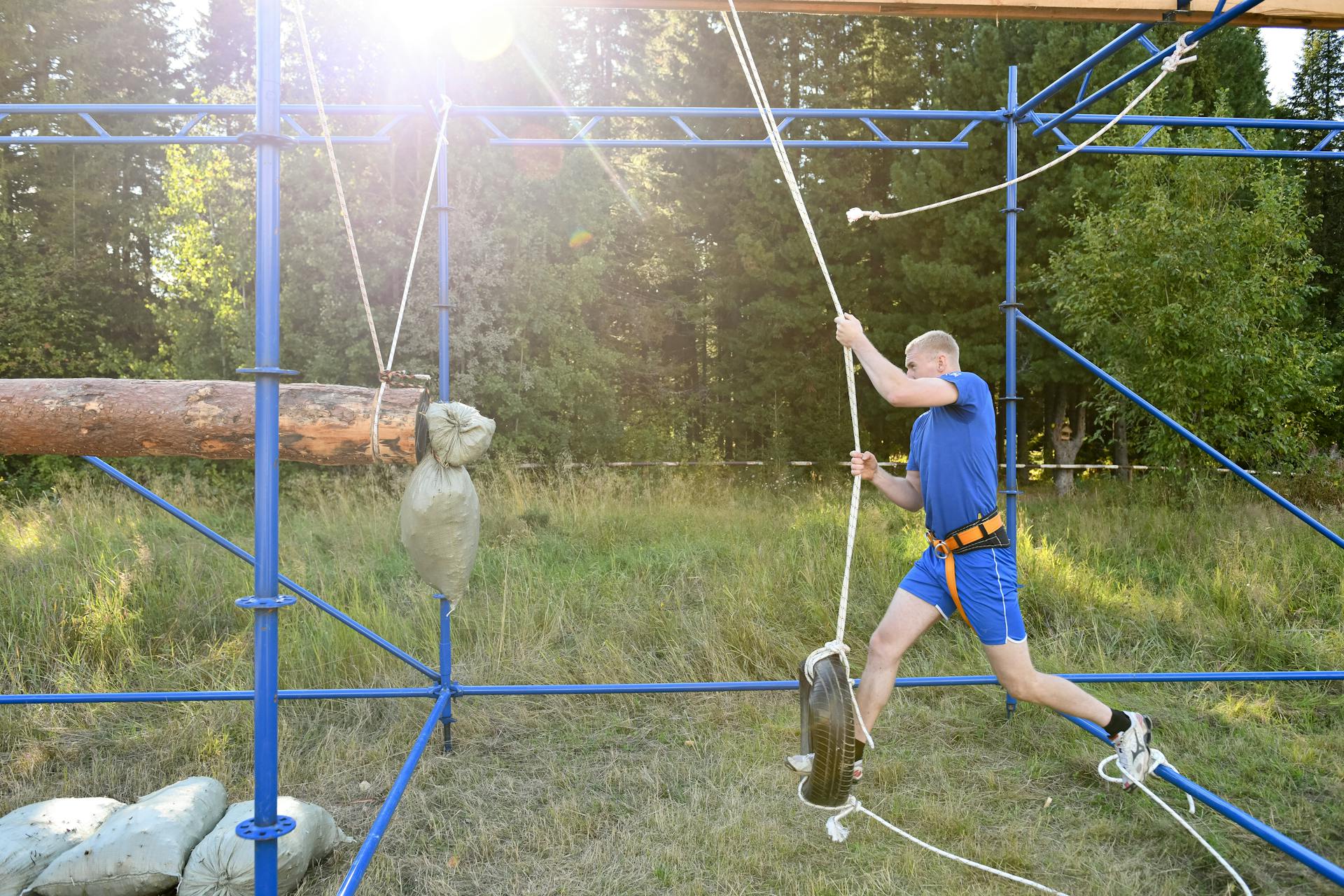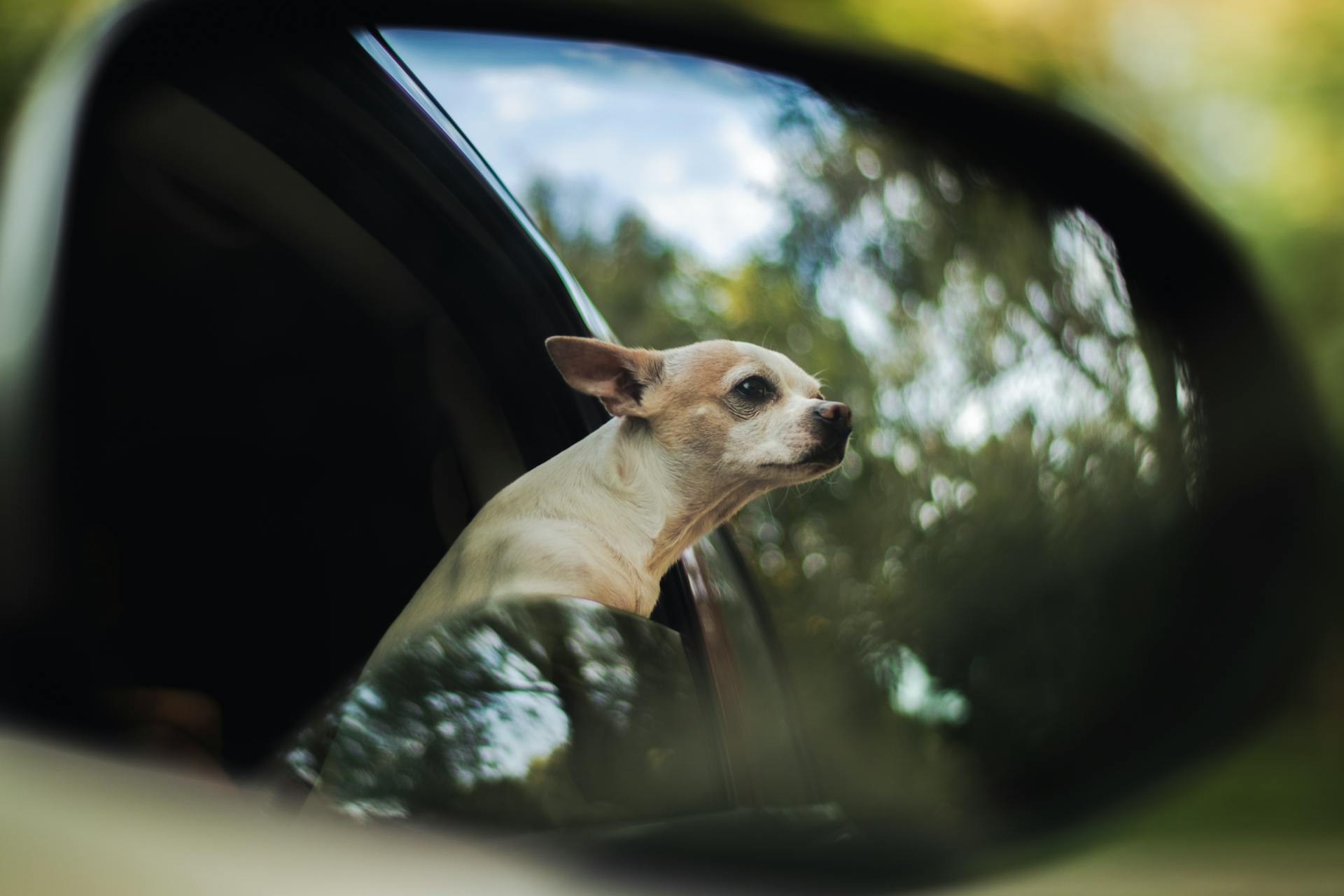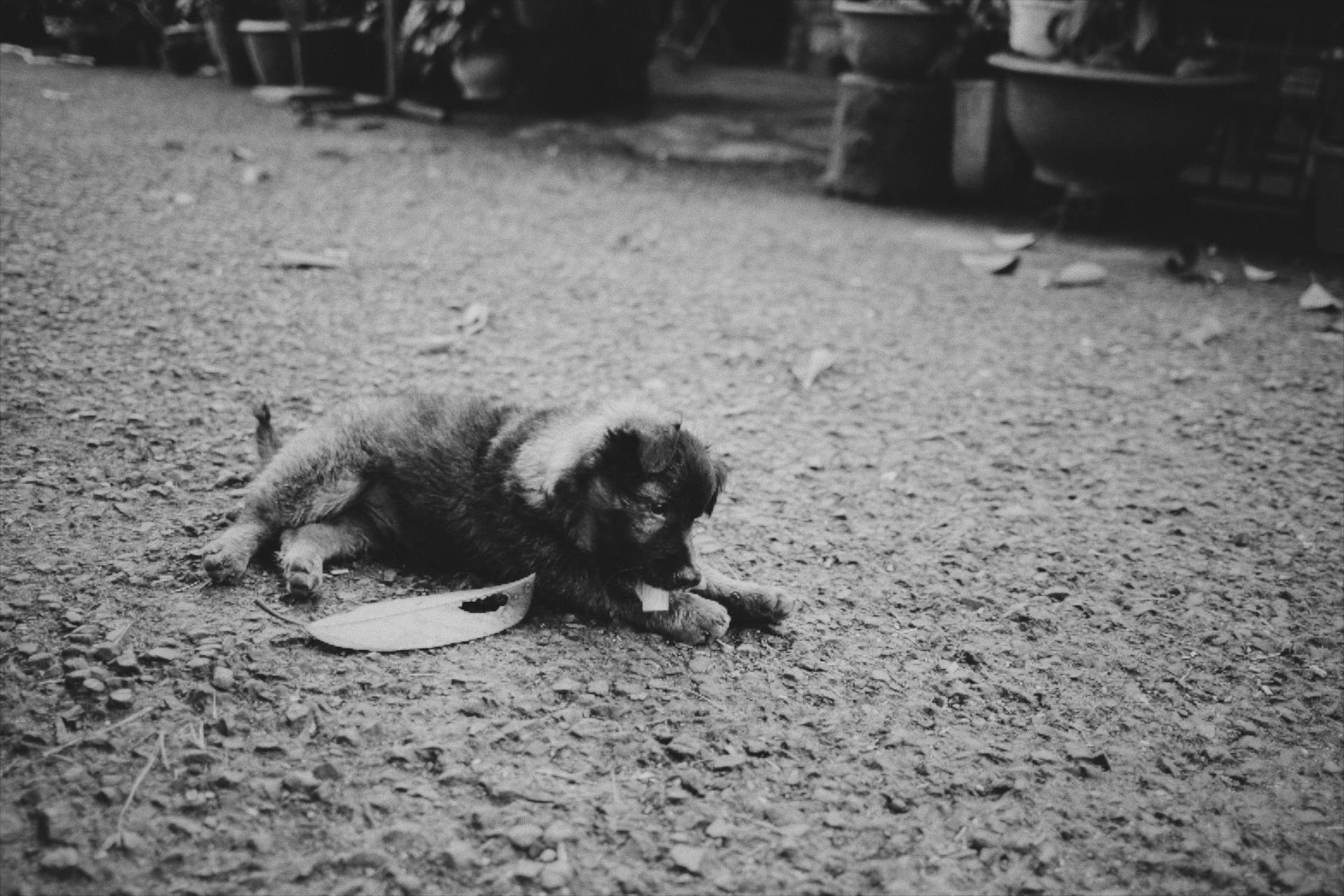
Cavapoos can suffer from separation anxiety, a common issue in many dog breeds. This condition is often caused by the dog's strong bond with its owner.
Cavapoos are highly social animals that thrive on attention and interaction, making it difficult for them to adapt to being alone. They can become anxious and destructive when left unattended.
Symptoms of separation anxiety in cavapoos include barking, whining, pacing, and even self-soiling. These behaviors can be distressing for both the dog and the owner.
Preventing separation anxiety in cavapoos requires a gradual separation process, starting with short periods of time and gradually increasing the duration.
Preparation and Prevention
To prevent separation anxiety in your Cavapoo, preparation is key. Think of it as setting the stage for success.
You can start by creating a designated safe space for your furry friend, lined with soft doggy bedding and favourite toys, where they can relax and unwind. This space should be cosy, comfortable, and equipped with all the things that make your Cavapoo feel secure.
Gradually increasing alone time in this safe space is crucial, starting with brief intervals and slowly building up. For example, you can leave your Cavapoo alone for a few minutes while you're in another room, then gradually extend the time as they grow more comfortable.
Interactive toys, such as puzzle toys, treat dispensers, or frozen Kong toys, can be a great distraction for your pup when you're not around. These toys provide mental stimulation and help reduce anxiety.
To prevent separation anxiety, you can also try leaving Kongs stuffed with peanut butter or cottage cheese ready for your Cavapoo to dig into as soon as you leave. Hiding small treats around the house or in their crate can also give your dog something to do while you're gone.
A crate can be an effective preventive tool, especially if your dog feels safe and secure in it. However, every dog is different, so it's essential to pay attention to which options are comforting to your dog and which aren't.
Curious to learn more? Check out: Shih Tzu Barking When Left Alone
Causes
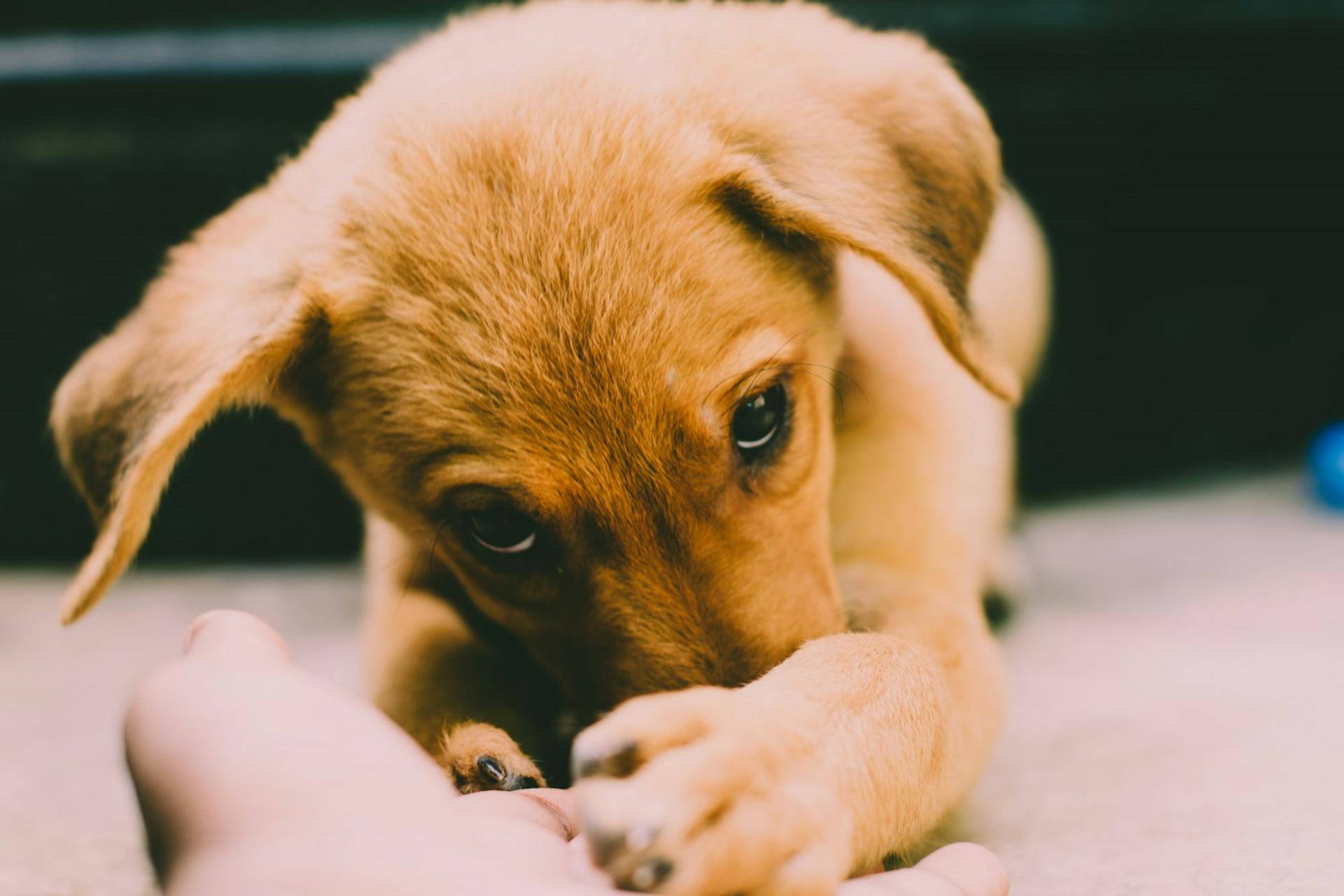
Separation anxiety can result from suffering a traumatic experience, such as a major earthquake or becoming lost in unfamiliar surroundings.
Sometimes a dog's past trauma can be triggered by a similar situation, causing them to develop separation anxiety.
The death of a person or another pet in the household can also trigger the onset of separation anxiety.
Some dog breeds simply have a genetic predisposition to separation anxiety, making it more likely to occur.
Early Training and Socialization
Early training and socialization are crucial for preventing separation anxiety in Cavapoos. This is especially true when you're starting with a puppy.
To make sure your Cavapoo grows up well-behaved and happy, it's essential to train and socialize them from an early age. Train your Cavapoo with traits and praises each time they do something desirable.
Firmly but calmly discourage them from repeating something improper. Cavapoos get easily sad and anxious when their owners seem displeased with them.
So, calmly handling misbehaviors is a must! Expose and socialize your Cavapoo with other animals and people too. Bonding with them all the time will make them more confident on their own.
This will let them live free from separation anxiety since they'll think that you're not the only source of fun and attention they have.
Here are some tips for socializing your Cavapoo:
- Start with short, positive interactions with other animals and people.
- Gradually increase the duration and intensity of these interactions.
- Make sure to reward your Cavapoo with treats and praise for calm behavior.
By following these tips, you can help your Cavapoo become a confident and well-adjusted companion.
Desensitization and Gradual Absences
Desensitization is a crucial step in helping your Cavapoo overcome separation anxiety. By gradually exposing your dog to departure cues in a controlled and calm environment, you can decrease their emotional response to these triggers.
Start by performing departure cues without actually leaving the house, such as putting on your shoes or jingling your keys. Repeat these cues in a relaxed manner, and provide a distraction or engage your pup in a positive activity, like giving them a treat or playing a game together.
Desensitization takes time and patience, but the results are worth it. By teaching your Cavapoo that departure cues don't always lead to your absence, you're reshaping their emotional response and empowering them to handle your departures with ease.
As your Cavapoo becomes more desensitised, gradually increase the intensity of the cues. For example, you can put on your coat or open the door briefly, but stay inside. Keep the environment relaxed and reinforce positive behavior.
To further build resilience, you can gradually increase the duration of your time away from your Cavapoo. Start by leaving the house for longer periods, such as a few hours, and ensure your furry friend is engaged and mentally stimulated before you go.
Here's a rough guide to help you get started:
Remember to monitor your Cavapoo's behavior during your absence and adjust the duration accordingly. If you notice signs of anxiety or distress, it may be necessary to take a step back and extend the duration more gradually.
Reducing Stress and Anxiety
Preventing separation anxiety in your Cavapoo starts with ensuring adequate physical and mental stimulation, giving them enough time to play and engage in activities that feed their energetic and enthusiastic nature.
Dogs thrive on routine, and knowing when to expect meals and playtime can bring a sense of comfort. Establish a consistent daily routine that includes alone time, and try not to make a big deal out of your departures.
A simple, confident goodbye is all your pup needs, and remember to stay calm and confident when leaving the house. If you're anxious or guilty about leaving, your pup will pick up on it.
Some signs of separation anxiety at night include trying to get into your room, whining, panting, or being very distressed vocally, pacing through the house endlessly, and even chewing on or biting items.
Here are some tips to reduce stress and anxiety in your Cavapoo:
- Provide interactive toys that challenge their minds and keep them occupied.
- Gradually reduce constant attention and interaction when you're together.
- Offer a special treat or a stuffed Kong toy before leaving the house to provide a positive distraction.
Music therapy can also be an effective way to calm your dog and ease their anxiety. You can find music specifically designed for dogs with separation anxiety online or at your local pet store.
Physical and Mental Stimulation
Cavapoos are energetic and enthusiastic dogs that require regular physical and mental stimulation to prevent destructive behavior. If they don't get enough exercise and mental stimulation, they might start eating non-food items, chewing on furniture, and barking excessively.
Cooping a Cavapoo up can lead to boredom, which can be just as bad for them as it is for us. They need time to play and engage in activities that challenge their minds and keep them occupied.
Providing interactive toys that challenge their minds is a great way to keep them busy. Puzzle toys, treat-dispensing balls, or snuffle mats can work wonders and help them associate alone time with fun and entertainment.
Reducing constant attention and interaction is key to building independence in your Cavapoo. Constant attention can inadvertently reinforce their separation anxiety, so it's essential to find a delicate balance between love and independence.
Building independence takes time, and it's a gradual process. Be consistent and celebrate every minor victory, and your Cavapoo will become more self-assured and less reliant on constant attention.
Related reading: Healthy Mind Canine - Separation Anxiety Training
Reducing Stress in Dogs
Reducing stress in dogs is crucial for their overall well-being. By establishing a consistent daily routine, you can help your dog feel more secure and less anxious.
Providing your dog with adequate physical and mental stimulation is essential to prevent destructive behavior. This includes giving them enough time to play and engage in activities that feed their energetic and enthusiastic nature.
A calm and confident goodbye is all your dog needs when you leave the house. Avoid making a big deal out of your departures, as this can exacerbate their anxiety.
Positive reinforcement is vital in shaping your dog's perception of being alone. Reward them with treats and engage in fun activities together when you return, helping them associate your departures with positive outcomes.
Gradually extending the duration of your departures can help your dog build resilience and adjust to longer periods of alone time. Start with small increments, such as five minutes, and gradually increase the time as your dog becomes more comfortable.
You might like: The Power of Positive Dog Training
Providing a positive distraction, like a special treat or a stuffed Kong toy, can help rewire your dog's anxious response and turn alone time into something positive and exciting.
Engaging your dog in calming activities, such as gentle massages or peaceful walks, can help them relax before you leave the house. This sets the tone for a stress-free alone time.
Reducing constant attention and interaction can help your dog develop their independence. Reward moments of independence, such as when they're relaxed on their own or engaged in a solo activity.
Music therapy can be an effective way to relax your dog and ease their anxiety. You can find music specifically designed for dogs with separation anxiety online or at your local pet store.
Hiring a dog walker or taking your dog to doggy daycare can also help ease their separation anxiety, especially if you're away from home for long periods of time.
A unique perspective: Positive Reinforcement Dog Training
Recognizing and Treating Separation Anxiety
If your Cavapoo suffers from separation anxiety, you may notice signs such as panting, whining, pacing, destructive behavior, and excessive barking.
These signs can be indicative of a deeper issue, and it's essential to talk to your veterinarian to create a plan to help your Cavapoo cope with its separation anxiety.
Desensitization is a common method to treat separation anxiety, which involves gradually acclimating your dog to your departure. This process can take eight weeks or less to bring symptoms under control.
To approach desensitization, start by getting your dog used to hearing the sound of your keys jingling, then add picking up your work bag, and so on, in baby steps.
Some dogs may develop an unusually strong attachment to their owners, leading to over-exuberant displays of affection upon return. This behavior can also occur at night, known as dog separation at night.
If your dog starts exhibiting behaviors such as trying to get into your room, whining, panting, or pacing through the house, it may be suffering from dog separation anxiety at night.
Expand your knowledge: Desensitization Dog Training
Here are some common signs of dog separation anxiety at night:
- Trying to get into your room by pawing and scratching at doors
- Scratching at windows when he goes out at night to do his business
- Whining, panting or being very distressed vocally by howling.
- Pacing through the house endlessly.
- Urinating and defecating in random places
- Chewing on or biting items and getting into the trashcan.
- Scratching at his face with his claws or biting his tail.
In Conclusion
It's possible to help your Cavapoo overcome separation anxiety with patience and training. Consistency is key, so it's essential to stick to a routine and make gradual changes.
You can start by desensitising your Cavapoo to your departure, which means making it a normal part of their day. This will help them build independence and reduce anxiety.
Remember, it's not about achieving perfection, but about building a bond of trust with your pooch. Celebrate every milestone along the way, big or small.
With a little patience and the right strategies, you can help your Cavapoo thrive when left alone. This means you'll have peace of mind, and your Cavapoo will be happy and content.
Here's a summary of the benefits of helping your Cavapoo overcome separation anxiety:
- Peace of mind you'll have when you leave the house
- No more neighbour complaints
- A happier dog
- A happy family
By following these steps and being consistent, you can help your Cavapoo live a happy and balanced life.
Frequently Asked Questions
Can Cavapoos be left alone for 8 hours?
Cavapoos can be left alone for 8 hours, but it's essential to vary the duration to prevent separation anxiety. Crate training can help ensure your Cavapoo's safety and well-being during extended periods of alone time
Can you train a Cavapoo to be left alone?
Yes, you can train a Cavapoo to be left alone, but it's essential to establish a routine and provide mental stimulation to prevent anxiety and boredom
Sources
- https://cavapoocrew.com/7-steps-to-vanish-cavapoo-separation-anxiety/
- https://content.tailster.com/cavapoos-and-separation-anxiety/
- https://dogtime.com/dog-health/dog-behavior/36-separation-anxiety
- https://www.dedicateddogtraining.com/dog-separation-anxiety-night/
- https://caninecarecentral.com/behavior/cavapoo-behavior-problems/
Featured Images: pexels.com
